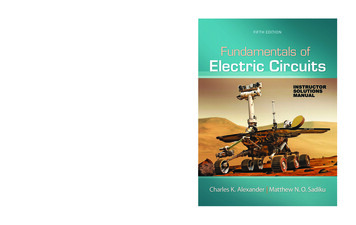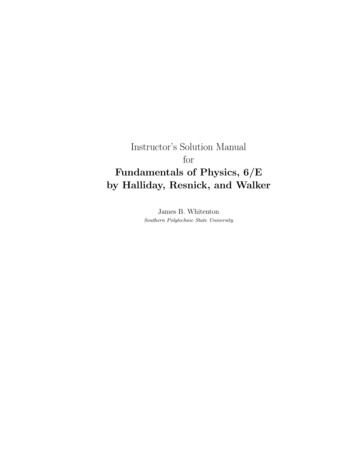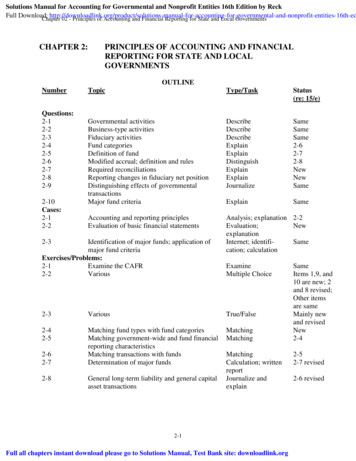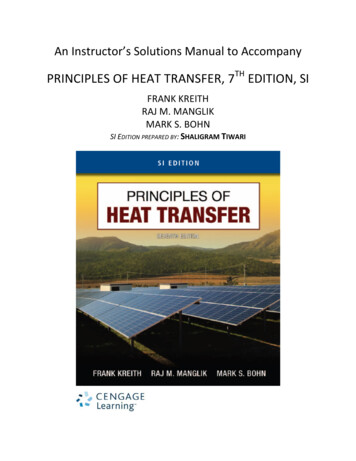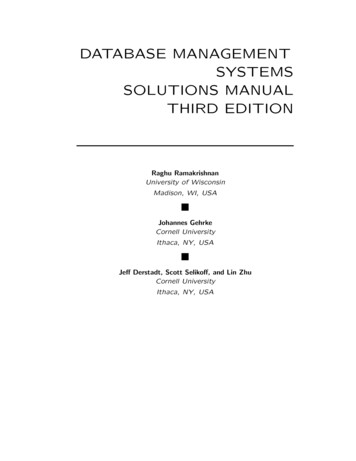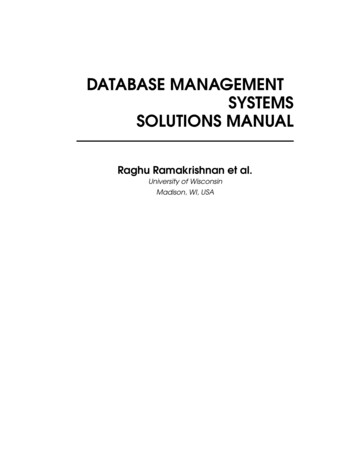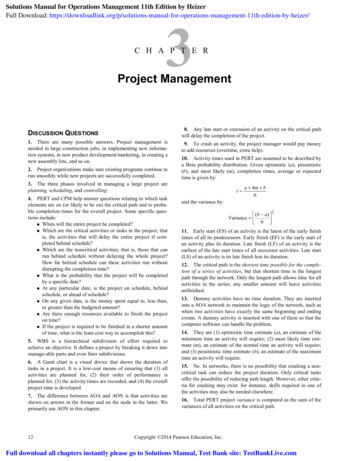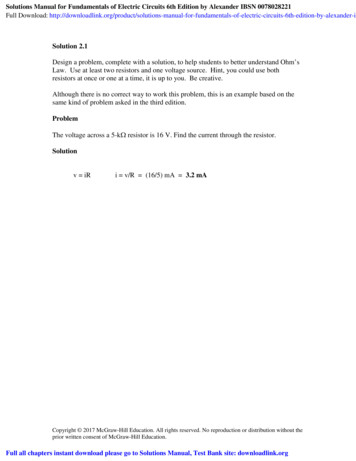
Transcription
Solutions Manual for Fundamentals of Electric Circuits 6th Edition by Alexander IBSN 0078028221Full Download: y-alexander-ibSolution 2.1Design a problem, complete with a solution, to help students to better understand Ohm’sLaw. Use at least two resistors and one voltage source. Hint, you could use bothresistors at once or one at a time, it is up to you. Be creative.Although there is no correct way to work this problem, this is an example based on thesame kind of problem asked in the third edition.ProblemThe voltage across a 5-kΩ resistor is 16 V. Find the current through the resistor.Solutionv iRi v/R (16/5) mA 3.2 mACopyright 2017 McGraw-Hill Education. All rights reserved. No reproduction or distribution without theprior written consent of McGraw-Hill Education.Full all chapters instant download please go to Solutions Manual, Test Bank site: downloadlink.org
Solution 2.2p v2/R R v2/p 14400/60 240 ohmsCopyright 2017 McGraw-Hill Education. All rights reserved. No reproduction or distribution without theprior written consent of McGraw-Hill Education.
Solution 2.3For silicon, ρ 6.4 x102 Ω-m. A π r 2 . Hence,ρL ρLR A π r2ρ L 6.4 x102 x 4 x10 2r2 0.033953πRπ x 240r 184.3 mmCopyright 2017 McGraw-Hill Education. All rights reserved. No reproduction or distribution without theprior written consent of McGraw-Hill Education.
Solution 2.4(a)(b)i 40/100 400 mAi 40/250 160 mACopyright 2017 McGraw-Hill Education. All rights reserved. No reproduction or distribution without the priorwritten consent of McGraw-Hill Education.
Solution 2.5n 9; l 7; b n l – 1 15Copyright 2017 McGraw-Hill Education. All rights reserved. No reproduction or distribution without theprior written consent of McGraw-Hill Education.
Solution 2.6n 8;l 8;b n l –1 15Copyright 2017 McGraw-Hill Education. All rights reserved. No reproduction or distribution without theprior written consent of McGraw-Hill Education.
Solution 2.76 branches and 4 nodesCopyright 2017 McGraw-Hill Education. All rights reserved. No reproduction or distribution without theprior written consent of McGraw-Hill Education.
Solution 2.8Design a problem, complete with a solution, to help other students to better understandKirchhoff’s Current Law. Design the problem by specifying values of i a , i b , and i c , shown inFig. 2.72, and asking them to solve for values of i 1 , i 2 , and i 3 . Be careful specify realisticcurrents.Although there is no correct way to work this problem, this is one of the many possible solutions.Note that the solution process must follow the same basic steps.ProblemUse KCL to obtain currents i 1, i 2, and i 3 in the circuit shown in Fig. 2.72 given that i a 2 amps,i b 3 amps, and i c 4 amps.Solutionibaiai2bi1ci3icdAt node a,At node b,At node c,̶ i a ̶ i 2 ̶ i b 0 or i 2 ̶ 2 ̶ 3 ̶ 5 ampsi b i 1 i c 0 or i 1 ̶ 3 ̶ 4 ̶ 7 ampsi 2 i 3 ̶ i 1 0 or i 3 ̶ 7 5 ̶ 2 ampsWe can use node d as a check, i a ̶ i 3 ̶ i c 2 2 ̶ 4 0 which is as expected.Copyright 2017 McGraw-Hill Education. All rights reserved. No reproduction or distribution without the priorwritten consent of McGraw-Hill Education.
Solution 2.9Findi1 , i 2 , and i3 in Fig. 2.73.–4 Ai21A–3 A–6 ABAi32Ai1–2 ACFigure 2.73For Prob. 2.9.SolutionStep 1.We can apply Kirchhoff’s current law to solve for the unknown currents.Summing all of the currents flowing out of nodes A, B, and C we get,at A, 1 (–6) i 1 0;at B, –(–6) i 2 2 0; andat C, (–2) i 3 – 2 0.Step 2.We now can solve for the unknown currents, i 1 –1 6 5 amps;i 2 –6 – 2 –8 amps; and i 3 2 2 4 amps.Copyright 2017 McGraw-Hill Education. All rights reserved. No reproduction or distribution without theprior written consent of McGraw-Hill Education.
Solution 2.102–8A14Ai2i13–6AAt node 1,–8–i 1 –6 0 or i 1 –8–6 –14 AAt node 2,–(–8) i 1 i 2 –4 0 or i 2 –8–i 1 4 –8 14 4 10 ACopyright 2017 McGraw-Hill Education. All rights reserved. No reproduction or distribution without theprior written consent of McGraw-Hill Education.
Solution 2.11 V1 1 5 0 V1 6 V2 V2 0 5 V2 3 V Copyright 2017 McGraw-Hill Education. All rights reserved. No reproduction or distribution without theprior written consent of McGraw-Hill Education.
Solution 2.12 30v –loop 2– 50v 40v- v2 – 20v –loop 1 v1–loop 3For loop 1,–40 –50 20 v 1 0 or v 1 40 50–20 70 VFor loop 2,–20 30 –v 2 0 or v 2 30–20 10 VFor loop 3,–v1 v2 v3 0 or v3 70–10 60 V v3–Copyright 2017 McGraw-Hill Education. All rights reserved. No reproduction or distribution without theprior written consent of McGraw-Hill Education.
Solution 2.132A7AI21I42344AI13AI3At node 2,3 7 I2 0 I 2 10 AAt node 1,I1 I 2 2 I 1 2 I 2 12 AAt node 4,2 I4 4 I 4 2 4 2 AAt node 3,7 I4 I3 I3 7 2 5 AHence,I 1 12 A,I 2 10 A,I 3 5 A,I 4 2 ACopyright 2017 McGraw-Hill Education. All rights reserved. No reproduction or distribution without theprior written consent of McGraw-Hill Education.
Solution 2.14 3V- V1I34V -V3 - I42V - - V4I2 V2 5VI1-For mesh 1, V4 2 5 0 V4 7VFor mesh 2, 4 V3 V4 0 V3 4 7 11V V1 V3 3 8V V2 V1 2 6VFor mesh 3, 3 V1 V3 0For mesh 4, V1 V2 2 0Thus,V1 8V ,V2 6V ,V3 11V ,V4 7VCopyright 2017 McGraw-Hill Education. All rights reserved. No reproduction or distribution without theprior written consent of McGraw-Hill Education.
Solution 2.15Calculate v and i x in the circuit of Fig. 2.79.12 Ω v10 V 16 V –– ix 4V3 ixFigure 2.79For Prob. 2.15.SolutionFor loop 1, –10 v 4 0, v 6 VFor loop 2, –4 16 3i x 0, i x –4 ACopyright 2017 McGraw-Hill Education. All rights reserved. No reproduction or distribution without theprior written consent of McGraw-Hill Education.
Solution 2.16Determine V o in the circuit in Fig. 2.80.16 Ω14 Ω 10 V Vo 25 V Figure 2.80For Prob. 2.16.SolutionApply KVL,–10 (16 14)I 25 0 or 30I 10–25 – or I –15/30 –500 mAAlso,–10 16I V o 0 or V o 10 – 16(–0.5) 10 8 18 VCopyright 2017 McGraw-Hill Education. All rights reserved. No reproduction or distribution without theprior written consent of McGraw-Hill Education.
Problem 2.17Obtain v 1 through v 3 in the circuit in Fig. 2.81.Figure 2.81For Prob. 2.17.Copyright 2017 McGraw-Hill Education. All rights reserved. No reproduction or distribution without theprior written consent of McGraw-Hill Education.
Solution 2.18Find I and V in the circuit of Fig. 2.82.I 3 amp20 Ω10 Ω4 amp20 ΩV–2 amp Figure 2.82For Prob. 2.18.Solution.Step 1. We can make use of both Kirchhoff’s KVL and KCL. KVL tells us that thevoltage across all the elements of this circuit is the same in every case. Ohm’sLaw tells us that the current in each resistor is equal to V/R. Finally we can useKCL to find I.Applying KCL and summing all the current flowing out of the top node andsetting it to zero we get, –3 [V/20] [V/10] 4 [V/20] – [–2] 0.Finally at the node to the left of I we can write the following node equation whichwill give us I, –3 [V/20] [V/10] I 0.Step 2. [0.05 0.1 0.05]V 0.2V 3–4–2 –3 or V –15 volts.I 3–V[0.05 0.1] 3–[–15]0.15 5.25 amps.Copyright 2017 McGraw-Hill Education. All rights reserved. No reproduction or distribution without theprior written consent of McGraw-Hill Education.
Solution 2.19Applying KVL around the loop, we obtain–(–8) – 12 10 3i 0i –2APower dissipated by the resistor:p 3Ω i2R 4(3) 12WPower supplied by the sources:p 12V 12 ((–2)) –24Wp 10V 10 (–(–2)) 20Wp 8V (–8)(–2) 16WCopyright 2017 McGraw-Hill Education. All rights reserved. No reproduction or distribution without theprior written consent of McGraw-Hill Education.
Solution 2.20Determine i o in the circuit of Fig. 2.84.io54V22 Ω –5ioFigure 2.84For Prob. 2.20SolutionApplying KVL around the loop,–54 22i o 5i o 0i o 4ACopyright 2017 McGraw-Hill Education. All rights reserved. No reproduction or distribution without theprior written consent of McGraw-Hill Education.
Solution 2.21Applying KVL,-15 (1 5 2)I 2 V x 0But V x 5I,-15 8I 10I 0,I 5/6V x 5I 25/6 4.167 VCopyright 2017 McGraw-Hill Education. All rights reserved. No reproduction or distribution without theprior written consent of McGraw-Hill Education.
Solution 2.22Find V o in the circuit in Fig. 2.86 and the power absorbed by the dependent source.10 Ω 10 ΩVoV1 25A2VoFigure 2.86For Prob. 2.22SolutionAt the node, KCL requires that [–V o /10] [–25] [–2V o ] 0 or 2.1V o –25or V o –11.905 VThe current through the controlled source is i 2V 0 –23.81 Aand the voltage across it is V 1 (10 10) i 0 (where i 0 –V 0 /10) 20(11.905/10) 23.81V.Hence,p dependent source V 1 (–i) 23.81x(–(–23.81)) 566.9 WChecking, (25–23.81)2(10 10) (23.81)(–25) 566.9 28.322 – 595.2 566.9 0.022which is equal zero since we are using four places of accuracy!Copyright 2017 McGraw-Hill Education. All rights reserved. No reproduction or distribution without theprior written consent of McGraw-Hill Education.
Solution 2.23In the circuit shown in Fig. 2.87, determine v x and the power absorbed by the 60-Ωresistor.5Ω6Ω vx 20 Ω10 Ω60 amp40 Ω60 Ω30 Ω15 ΩFigure 2.87For Prob. 2.23.Step 1. Although we could directly use Kirchhoff’s current law to solve this, it will beeasier if we reduce the circuit first.The reduced circuit looks like this,5Ω vx60 ampR1R2R3R4R510 ΩR5 40x60/(40 60) 6 R1 15x30/(15 30) 20 R 3 R 2 R 4 /(R 2 R 4 )Letting V 10 v x V R5 and using Kirchhoff’s current law, we get60 V 10 /10 V 10 /(5 R 5 ) 060 V 10 /10 V 10 /20 0V 10 –60x20/3 –400 voltsCopyright 2017 McGraw-Hill Education. All rights reserved. No reproduction or distribution without theprior written consent of McGraw-Hill Education.
We could have also used current division to find the current through the 5 Ω resistor,however, i 5 V 10 /(5 R 5 ) and v x 5i 5Calculating the power delivered to the 60-ohm resistor requires that we find the voltageacross the resistor. V R5 V 10 – v x ; using voltage division we get V 60 [V R5/(6 R 1 )]R 1 . Finally P 60 (V 60 )2/60.Step 2.R1R2R3R4R5 40x60/(40 60) 2400/100 24; 6 R 1 6 24 30; 15x30/(15 30) 450/45 10; 20 R 3 20 10 30; R 2 R 4 /(R 2 R 4 ) 30x30/(30 30) 15.Now, we have 60 (V 10 /10) (V 10 /(20)) 0 or V 10 –60x20/3 –400 andi 10 –400/20 –20 andv x 5i 5 5(–20) –100 volts.V R5 V 10 – v x –400 – (–100) –300; using voltage division we getV 60 [V R5 /(6 R 1 )]R 1 . [–300/30]24 –240. Finally,P 60 (V 60 )2/60 (–240)2/60 960 watts.Copyright 2017 McGraw-Hill Education. All rights reserved. No reproduction or distribution without theprior written consent of McGraw-Hill Education.
Solution 2.24(a)I0 VsR1 R2V0 α I 0 (R3 R4 ) αVsR 3R 4 R1 R 2 R 3 R 4V0 αR3 R4 Vs ( R1 R2 )( R3 R4 )(b)If R 1 R 2 R 3 R 4 R,V0α R α 10VS 2R 2 4α 40Copyright 2017 McGraw-Hill Education. All rights reserved. No reproduction or distribution without theprior written consent of McGraw-Hill Education.
Solution 2.25V 0 5 x 10-3 x 10 x 103 50VUsing current division,I 20 5(0.01x50) 0.1 A5 20V 20 20 x 0.1 kV 2 kVp 20 I20 V 20 0.2 kWCopyright 2017 McGraw-Hill Education. All rights reserved. No reproduction or distribution without theprior written consent of McGraw-Hill Education.
Solution 2.26For the circuit in Fig. 2.90, i o 5 A. Calculate i x and the total power absorbed by theentire circuit.ix25 Ωio20 Ω10 Ω5Ω40 ΩFigure 2.90For Prob. 2.26.SolutionStep 1. V 40 40i o and we can combine the four resistors in parallel to find the equivalentresistance and we get (1/R eq ) (1/20) (1/10) (1/5) (1/40).This leads to i x V 40 /R eq and P (i x )2(25 R eq ).Step 2. V 40 40x5 200 volts and (1/R eq ) (1/20) (1/10) (1/5) (1/40) 0.05 0.1 0.2 0.025 0.375 or R eq 2.667 Ω and i x 200/R eq 75 amps.P (75)2(25 2.667) 155.62 kW.Copyright 2017 McGraw-Hill Education. All rights reserved. No reproduction or distribution without theprior written consent of McGraw-Hill Education.
Solution 2.27Calculate I o in the circuit of Fig. 2.91.8Ω10V Io3Ω6ΩFigure 2.91For Prob. 2.27.SolutionThe 3-ohm resistor is in parallel with the c-ohm resistor and can be replaced by a[(3x6)/(3 6)] 2-ohm resistor. Therefore,I o 10/(8 2) 1 A.Copyright 2017 McGraw-Hill Education. All rights reserved. No reproduction or distribution without theprior written consent of McGraw-Hill Education.
Solution 2.28Design a problem, using Fig. 2.92, to help other students better understand series and parallelcircuits.Although there is no correct way to work this problem, this is an example based on the samekind of problem asked in the third edition.ProblemFind v 1 , v 2 , and v 3 in the circuit in Fig. 2.92.SolutionWe first combine the two resistors in parallel15 10 6 ΩWe now apply voltage division,v1 14(40) 28 V14 6v2 v3 Hence,6(40) 12 V14 6v 1 28 V, v 2 12 V, v s 12 VCopyright 2017 McGraw-Hill Education. All rights reserved. No reproduction or distribution without the priorwritten consent of McGraw-Hill Education.
Solution 2.29All resistors (R) in Fig. 2.93 are 10 Ω each. Find R eq .RRReqRRRRRFigure 2.93For Prob. 2.29.SolutionStep 1.All we need to do is to combine all the resistors in series and in parallel. R(R) R(R) R(R R) R R R R R R R R eq which can be derived by inspection. We R(R) R(R) R(R R) R R R R R R R will look at a simpler approach after we get the answer.R eq Step 2.5[( 5 6.667 )] 58.335 3.5 Ω. 5 5 6.667 16.66710 Ω10 ΩReq10 Ω
same kind of problem asked in the third edition. Problem The voltage across a 5-kΩ resistor is 16 V. Find the current through the resistor. Solution v iR i v/R (16/5) mA 3.2 mA Solutions Manual for Fundamentals of Electric Circuits 6th Edition by Alexander IBSN 0078028221
